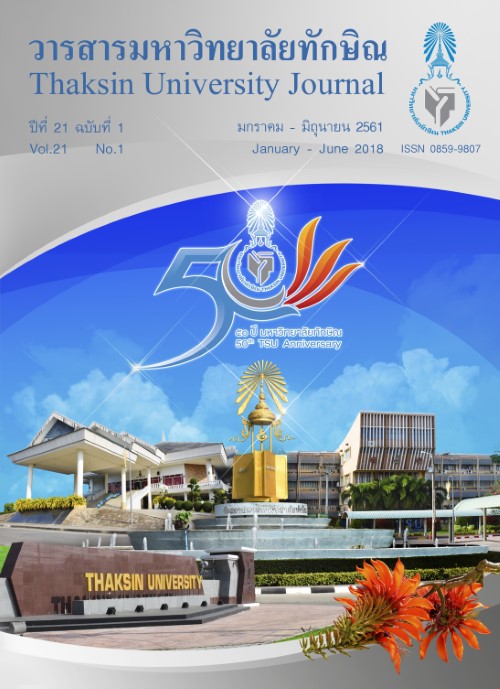Thai Massage of Low Back Pain Treatment: A Case Study of Folk Healer in Songkhla Province
Main Article Content
Abstract
This qualitative research is conducted to reveal the traditional knowledge for low back pain treatment using massage technique performed by a folk healer, who lives in Songkhla province, and is compared the massage line with the anatomical positions. Information was collected through in-depth interviews, participant and non-participant observations and digital motion video recording. Results were analyzed by descriptive statistics. In October 2016, the most frequency symptom of musculoskeletal disorders’ patients was low back pain. The treatment was started by observing the patients’ walking posture and examining their body by especially focusing on their low back pain. The folk healer give massage whole body with a technique of bone-peeling massage. Stress massage on 3 line of back muscles including Spinalis muscle, Longissimus muscle and Iliocostalis muscle a bone adjustment of Thoracolumbar vertebral were done using an arrow-shooting posture. Therefore, using the massage as well as bone adjustment may case the relaxation of the muscle and improve the balanced
of body structure, which could reduce the low back pain.
Article Details

This work is licensed under a Creative Commons Attribution-NonCommercial-NoDerivatives 4.0 International License.
References
of Tradition Thai Mendicine Foundation.
[2] Pratrakard, P. and Chankade, R. (2007). Thai Traditional Medical Situation Report Folk Medicine and
Alternative Medicine 2005-2007. Nonthaburi: Manus Film Limited Partnership.
[3] Teerachitkul, J., Naka, K. and Boonphadh. (2012). “Management of Muscular Aches and Pains in Old-Age Rubber
Tappers”, Thai Journal of Nursing Council. 27(2), 134-146.
[4] The National Health Development Plan Ministry of Public Health. (2017). National Health Development
Plan during the 12th National Economic and Social Development Plan (2017-2021). Bangkok:
The Veterans Administration Printing House under the Royal Patronage of the King.
[5] Sugsamran, P. (2008). “Traditional Health Care and Healing by Folk Healers: Case Study in Amphur Muang,
Khon Kaen Province”, Thai Traditional and Alternative Medicine. 6(1), 59-64.
[6] Untimanon, O., Boonmeephong, K., Saipang, T., Sukanun, K., Promrat, A., Julraung, P. and Pornpiroonrod, S.
(2016). “Burden of Back Pain Among Working Populations”, Disease Control. 42(2), 119-129.
[7] Pornsiripong, S. (2009). “The Inheritance of Thai Folk Medicine”, In Academic Department of Sukhothai
Thammathirat Open University. Medical Sociology and Anthropology. 145-148. Bangkok:
Aroonprinting.
[8] Mori, H., Ohsawa, H., Tanaka, T.H., Taniwaki, E., Leisman, G. and Nishijo, K. (2004). “Effect of Massage
Blood Flow and Muscle Fatigue Following Isometric Lumbar Exercise”, Medical Science Monitor.
10(5), 173-178.
[9] Prapasanon, M. (2006). Body Balance of Department of Thai Traditional and Alternative Medicine
(Online). Retrieved 23 March 2017, from http://www.thaicam.go.th/images/BackPain_Chapter8.pdf.

